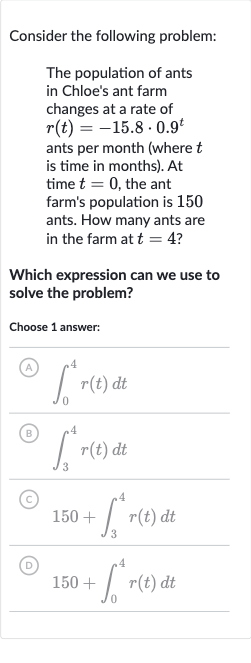AI tutor
Welcome to Bytelearn!
Let’s check out your problem:

Consider the following problem:The population of ants in Chloe's ant farm changes at a rate of ants per month (where is time in months). At time , the ant farm's population is ants. How many ants are in the farm at ?Which expression can we use to solve the problem?Choose answer:(A) (B) (C) (D)
Full solution
Q. Consider the following problem:The population of ants in Chloe's ant farm changes at a rate of ants per month (where is time in months). At time , the ant farm's population is ants. How many ants are in the farm at ?Which expression can we use to solve the problem?Choose answer:(A) (B) (C) (D)
- Initial Population and Rate Function: To find the number of ants at , we need to account for the initial population and the change in population over time. The initial population is given as ants at . The rate of change of the population is given by the function . To find the total change in population from to , we need to integrate the rate function over this interval.
- Definite Integral Calculation: We will use the definite integral to calculate the total change in population from to . The integral of the rate function over the interval from to will give us the net change in the population during this time period.
- Total Number of Ants at : The correct expression to calculate the total number of ants at is the initial population plus the integral of the rate function from to . Mathematically, this is represented as:
- Correct Choice Explanation: Looking at the given options, we can see that option (D) matches the expression we derived:(D) This is the correct choice because it starts with the initial population and adds the change in population from to .
- Incorrect Options Explanation: To confirm, options , , and are incorrect because: does not include the initial population. starts integrating from , which would not account for the change from to . includes the initial population but starts integrating from , which also does not account for the change from to .
